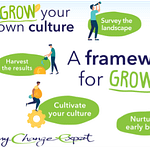Recent surveys suggest many leaders are focused on reinventing their business. Catalysed by the pandemic, the world of work is changing at a dizzying pace and CEOs fear their company will be left behind.
In 2023, businesses are reimagining their place in the world, and a critical question C-suite must answer, of course, is the how. How do you change tack effectively as an organisation, taking your people with you on the journey? With reinvention on the agenda, the key to your success may well lie in a new strategy for organisational engagement.
Data about the value of employee engagement as part of change management are huge, but plenty of evidence exists in many businesses to support a sharp focus on this area.
You may be reinventing your company to stay viable, but the traditional goals still apply – competitive advantage, a confident workforce, low levels of sickness and attrition, and a high level customer experience. Central to achieving these goals is your company culture, and this is sustained through change by how you engage with your people.
Speaking to CEOs recently, my advice has been this – consider the three cultural pillars upon which all strong, sustainable enterprises are built:
- What we believe – know the purpose of the organisation, why it exists and what the future ambition looks like
- How we behave – your people need to be prepared to act and do things differently
- The tools we use – for example, recognition schemes, bonus structures, talent plans and other systems and processes
To re-build your company, you need all three pillars to be strong. A clear purpose and direction that achieves buy-in and is effectively translated into results. This is not as clear cut as it sounds, however, and its success or failure is determined by your employee engagement. Strong, positive relationships with your people will create three sturdy pillars of company culture on which you can build.
So, consider the different factors that drive employee engagement. According to Best Companies LLP, these include your manager, your company, personal growth and leadership. Other drivers are getting a fair deal, giving something back, your team and wellbeing. People are motivated in many different ways to perform.
And when I talk to businesses about organisational engagement, I present these four levels:
- Understanding – I understand where we are going and what I need to do.
- Commitment – I feel and am committed to delivering for this organisation.
- Attachment – I have a positive emotional attachment with the organisation.
- Significance – I see significance in what I do each day as part of this organisation and it aligns with my personal values and what gives me meaning in life.
If you are planning to embark on a new direction for your organisation, you need to create understanding and context throughout the change, and the key question you need to answer as a leader is the why. The ‘why’ part of the story is often lost in the eagerness of the leadership team to explain what is happening and what it means for the individual employee. The ‘why’ is the context and can make a huge difference to whether the change is accepted or rejected.
To achieve commitment, you will need to communicate very clearly the new direction of the organisation, and most importantly its purpose. Has the purpose of your organisation altered also? The reinvention of a business does not necessarily change its reason for existence. At the very least, strong, clear communication about the purpose and new direction, and opportunities for employees to engage, will help ensure your people are emotionally invested.
There are various levers to achieve attachment. Invest in your people for the long term. Pay attention to their wellbeing and provide a meaningful benefits package. Share ownership schemes can be an excellent mechanism for strengthening that bond with employees. Companies that invest in career development will often see returns in their people’s emotional attachment.
And this bring us to the peak of employee engagement: significance. There is a large body of research that evidences the link between personal significance, meaning and performance. It’s clear that high engagement levels come when people see a deep connection between the purpose and values of the organisation and what’s important to them. This alignment can be achieved through talent retention and recruitment strategies. It is also helped by how the organisation prioritises corporate social responsibility. People want to see the organisation they work for give something back.
If the trend this year is indeed towards reinvention, how leaders approach employee engagement will be critical in strengthening those three cultural pillars and reimagining a purposeful, united, results-driven organisation.
Author: Jane Sparrow – Founder & CCO of Tuddl, and Director of The Culture Builders
Photo credit: Cottonbro studio




